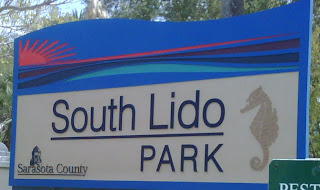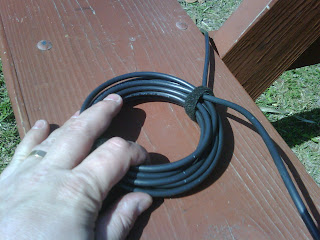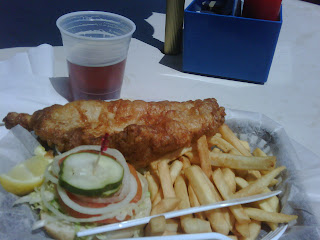Posts Tagged ‘NA-034’
 The NA-034 operation that almost wasn’t, Part II
The NA-034 operation that almost wasn’t, Part II
It turns out that there was indeed a park at the southern end of the island named South Lido Park that was the perfect location to try again. There was a parking lot that bordered the park, and there were a few parking spots that were close enough to picnic tables that I could easily set up the radio and antenna on a table (or even on different tables) with the power cables connected to the car battery. This seemed like a good opportunity to get the antenna even farther away from the car and the radio, and hopefully away from the source of the RF interference. I set up the antenna, and was able to throw the counterpoise over a nearby low tree branch. (One of the recommendations for this particular antenna is to keep the counterpoise at least 2 feet off the ground.) I carefully checked the SWR with the antenna analyzer and found a good match.
I decided to try to eliminate the feedline that I’d brought with me as a possible issue, so I connected the antenna to the radio with a very short (about .5 meter) patch cable that I’d brought with me. Normally it’s not a very good idea to set up that close to the antenna, but I figured that for diagnostic purposes I could do it. It turns out that I wasn’t going to transmit very long that way anyway since I had the same problem. At this point, I decided to go back to the regular feedline, which is a 15m length of RG-8x that I’ve used for the past several years without issue. What I did was to create an RF choke by coiling some of the excess feedline at the feedpoint. The idea behind doing this is to help keep RF off the outside of the feedline, where it can radiate and cause issues. Unfortunately, that didn’t seem to help either.
During these tests, in addition to just hearing the odd noise in my headset, and on the radio speaker when I disconnected the headset, I was attempting to call some stations that I had been hearing all afternoon. The location that I had now moved
to was even better than my previous location, as there was water on 3 sides, which means I had an especially good path to Europe, South America, and the southwest US. Some of the stations that I’d tried to contact were extremely strong and should not have been difficult at all to contact. I was finally able to make a contact with S55OO so I knew that the radio was actually transmitting, though he was in the middle of working many other stations so I didn’t have a chance to ask him for a signal report. At that point, I was confused and frustrated at not being able to locate the source of the problem, and given that it was getting late in the afternoon, I decided to break down and shut down for the evening.
After heading back home (well, not to NJ, to where we were saying), I sent an email the Buddipole Users Group to see if anyone there had any ideas what the problem might be. I got back responses from a number of folks within a few hours, most of them suggesting that I try most of the things I’d already tried (which of course they didn’t know I’d done). A couple of folks suggested trying to use some ferrite beads in various places on power cable, microphone cable, and power cables. Unfortunately, I didn’t have any with me, and they aren’t the kind of thing that are stocked in a local hardware store or even Radio Shack. Budd, W3FF, and Scott, NE1RD pointed out that since I’d made one contact that the radio must be transmitting, but it did seem that there was still some problem.
The next morning, I woke up, checked my email and found a few more things to try, packed up the car, and headed out for lunch at The Old Salty Dog on nearby Siesta Key. I was still frustrated that I hadn’t figured out what the problem was, but things always seem better after a beer and a fried Grouper sandwich. They probably would have seemed even better after two or three beers, but since I still had to drive back to the operating site I decided to stop after one.
When I arrived at South Lido Park, I found an even better location than on the previous day, where the operating position was under trees for shade and I was able to set up the antenna on a different table from the operating position, putting even more distance between the antenna, the radio, and the car. I made sure to have the RF choke in place as close as possible to the feedpoint, and wound up as much of the excess feedline into that choke to try to eliminate as much of the unwanted RF on the outside of the feedline as possible.
I was still hearing what I thought was RF in my headset (or from the radio speaker when I switched to the hand microphone), but I decided to call CQ anyway, hoping that perhaps someone would be able to hear me and perhaps let me know what my on-air signal sounded like. I finally got an answer back from Larry, KH6ITY who, as it turns out, was a technology teacher in Texas and was in the middle of demonstrating ham radio to his class. As it turned out, meeting Larry on the air was a wonderful stroke of luck.
 The NA-034 operation that almost wasn’t, Part I
The NA-034 operation that almost wasn’t, Part I
As I mentioned in my posting from last week, I spent a few days in Florida recently. I was down there visiting family, but had free time in the afternoons and had planned on operating for a few hours each day from Lido Key, which is IOTA designator NA-034. Briefly, IOTA (Islands On The Air) is a program where hams operate from various islands all over the world and make contacts with other hams. There’s an awards program for contacting various numbers of islands. The rules (link goes to a PDF file) for what qualifies as an island for IOTA purposes are a bit complex, but Lido Key, just west of Sarasota, Florida, qualifies. I’ve made a couple of trips down there in the past and had a lot of fun operating from that location.
My plan was to head out to the parking lot of Lido Beach and set up there, as I’ve done in the past.This location is very easy to get to, and the parking lot has never been full when I’ve been there, so I can take up as much space as I need. For this portable operation, instead of using hamsticks (which are very straightforward to use but since they are nearly 2 meters long, are hard to ship), I decided to use my Buddistick vertical antenna. I’ve written about the Buddistick quite a bit here before, you can do a search from the search box on the right of the blog home page for “buddistick” to see all the references. Because Sharon and I didn’t want to have to check baggage, I shipped the radio (my trusty Icom 706MkIIG), feedline, power cables, and Buddistick down to a relative a couple of days before we left NJ.
I set up the radio and initially mounted the antenna on the rear of the rental car, a Mazda 5, which seemed to be a good way to get it up fairly high and also allowed me to toss the counterpoise wire over a low tree branch. (It’s a bit difficult to see, but you can view the counterpose wire just above the bottom of the picture, it’s the very thin wire.) I set up the antenna, configured it for 20m, and checked it with the antenna analyzer, where I found that I had excellent SWR at my intended operating frequency of 14.260Mhz (one of the standard IOTA frequencies). I connected the antenna to the feedline, and used the built-in SWR testing in the radio to ensure that the SWR was still good (it was), found that my intended frequency was unoccupied, and started to call CQ. That’s when I discovered that I had a pretty serious problem.
The problem was that when I keyed the radio and called CQ, I could hear a lot of what sounded like RF feedback in the headset. My assumption was that for some reason, the transmitted signal from the transmitted signal from the radio was being fed back into the radio, and causing the noise that I was hearing in my headset. As it turned out, I was wrong about the source of the problem, but I didn’t find that out for another 24 hours. Working on that initial assumption, I tried to move the antenna to a slightly different location on the car, and even tried to use the very small Buddistick tripod to place the antenna on the ground much farther away from the car, but had no success. (By the way, that’s a wonderful little tripod, but it’s really not designed to work on a concrete parking lot surface where you can neither dig the legs in nor secure it to anything. All it took was a tiny breeze to knock over the antenna. Fortunately, no damage was done to the whip antenna, but I’ll be a bit more careful about trying that again.)
At that point, I had to take a break from troubleshooting to join a conference call at work. (Yes, even though I was on vacation.) After the call and a follow-up call, about 90 minutes had passed. I tried a few more attempts to play with the radial height, move the location of the radio, and to create an RF choke by coiling some feedline at the feedpoint of the antenna, but was still having no success. I decided to try to find another operating location, hoping to find a park where I could mount the antenna on a picnic table much farther away from the radio, hoping that any RF problems coming from the antenna would be significantly reduced by the distance. I looked at the GPS I’d brought with me and it appear to show a park farther south on the island, so I put all the gear in the car, and headed south.
The saga continues in Part II.
 Another operation from Lido Key, NA-034
Another operation from Lido Key, NA-034
I just wanted to put up a quick note to say that I expect to be active from IOTA NA-034, Lido Key from March 22-24, 2010. I’ll be down there visiting family but I expect to have a few hours each day (probably between about 15:00-20:00 GMT) to operate. Instead of using hamsticks as I have in the past, I’m going to be using my Buddistick which gives me a bit more flexibility as to the bands I’ll be using (and was a lot easier to ship; I didn’t want to have to deal with checking a 6-foot long hamstick for the flight). It should perform reasonably well since my normal operating position is from a parking lot that’s just a few dozen meters from the Gulf of Mexico, and the saltwater should help with propagation, particularly to the south and west.
Most likely I’ll only be on SSB for this short trip, and I’ll stay close to the standard IOTA frequencies, primarily on 20m (14.260) and 15m (21.260), though I may move around if the bands cooperate.
If anyone is in the area (Sarasota, FL) and wants to get together during one of those afternoons, please drop me line.














